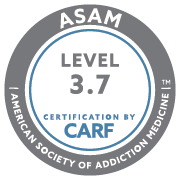
In our last couple of blogs, we have been talking about psychodrama therapy. This is our third blog on the subject in our four-blog series. This week, we really get into the “meat and potatoes” of what this experiential group therapy is all about by talking about various techniques used in the therapy setting.
So far, we have explained that psychodrama is an interactive method of therapy that uses group interaction and role play to help patients delve into and investigate their inner and outer worlds and experiences. Psychodrama is action-oriented and helps patients practice new behaviors in all realms of their lives. This is just one of the many clinical services we offer at New Directions for Women.
We have also talked about the therapeutic value of this approach and explained why it is used in addiction treatment. Psychodramatic therapy is highly transformative and helps addicted women find healing from old trauma wounds so they can get sober and learn how to live a life in recovery.
Now, let’s discuss psychodrama techniques. Doing so will really help you understand how this group therapy works and what happens in sessions.
Some Basics About What Happens in Group Therapy Sessions
You have probably heard a lot about psychotherapy (also known as “talk therapy”) over the years and may have even participated in some sessions. This is when you sit with a therapist or psychologist and work one-on-one. Psychodrama is nothing like this.
Psychodramatic sessions happen with small peer groups with a specially trained therapist supervising. These are usually weekly sessions that typically last anywhere from an hour to two hours.
Each psychodrama focuses on the specific life situation of one member of the group, who is usually referred to as the “protagonist.” Group members take on assigned roles as needed in order to act out a given scenario where specific techniques are used.
A psychodrama group session is generally executed in three phases: the warm-up phase, the action phase, and the sharing phase. By implementing drama acting and roleplay, the protagonist and her peers are given the opportunity to develop insight into issues from the past, recognize challenges impacting present circumstances, and identify future possibilities.
Everyone who participates in psychodrama exercises benefits from the experience, not just the protagonist.
Understanding the Three Phases of This Transformative Trauma Therapy

We mentioned that psychodrama therapy happens in three phases.
The warm-up phase helps to establish trust, group unity, and a sense of safety among peer members. These dynamics are essential to a psychodrama group because without them, peers may not feel comfortable performing dramas or exploring conflict with one another.
The action phase, as you might have guessed, is where all of the drama takes place.
During this phase, the protagonist – with guidance from the therapist – creates a scene based on a significant past event from her life. If you were to compare a psychodrama to a movie, the therapist would be the director. Other members of the group serve as “auxiliary egos” or they play people from the protagonist’s real life. Those who do not take on active acting roles participate as observant audience members. Every individual who takes part in a psychodrama learns from the experience, whether they are a protagonist or in the audience.
The following four techniques are commonly used as part of the action phase:
- Role reversal: This technique asks the protagonist to step outside of herself and act out the role of some other significant person in the scenario. This can help her better understand the other person’s perspective, which helps to develop empathy. This can ultimately lead to forgiveness of someone the protagonist has resented for many years.
- Mirroring: In this psychodrama technique, the protagonist becomes an observer. Auxiliary egos act out the part of the protagonist and roleplay an event so the protagonist can watch. This technique can be especially helpful when the protagonist feels disconnected from appropriate emotions about the scenario.
- Doubling: During this exercise, a peer member acts as the protagonist and adopts her behavior and movements, expressing feelings or thoughts likely associated with the event. This technique can be used to build empathy for the protagonist, but it can also be used to challenge some aspect of her personality, behavior, or actions. This is done in a compassionate and nonconfrontational way.
- Soliloquy: You may remember this literary term from your days in high school when you studied Shakespeare. Here, the protagonist shares her inner thoughts, perspectives, and emotions to the audience or a double in a type of monologue.
Okay. We have talked about what happens during the warm-up and action phases. Now, let’s talk a little bit about what happens during the sharing phase of a psychodrama.
During the sharing phase, the director reverts back to the role of therapist to allow the peers and the protagonist to process their thoughts and feelings about the psychodrama technique that was used.
The sharing phase is vital to the psychodrama group because it is essential to the transformational process of all peer members who participated. It allows time for group discussion about what took place during the action phase.
There you have it. A summary of psychodrama techniques and an overview of what happens during this unique type of group therapy.
Be sure to check out our final blog where we will tell you five ways you could benefit from psychodrama in rehab.
We Are Still Accepting New Patients During the COVID-19 Crisis
Although we wish it were different, the COVID-19 pandemic is still underway. Many businesses still remain closed. However, New Directions for Women continues accepting new patients and we have been since the pandemic started.
We recognize that women across the country are still in desperate need of lifesaving substance use disorder treatment. That’s why we’re here. We have been helping women get sober for more than 40 years and we will continue to do so.
We remain fully operational during these uncertain times and continue to take extensive safety precautions to prevent the spread of the coronavirus.
When You’re Ready to Get Help, We’re Here
New Directions for Women offers treatment for women of all ages, pregnant women, and women with children. We provide detox services in a social model setting, offer a residential facility that feels like home, and have a highly effective outpatient program. We also have intensive sober living available in addition to an aftercare program.
When you’re ready to get sober and find a new way to live, we’re here. We are happy to address any concerns you may have about COVID-19 and our facility. We do not want fear of this virus to stop you from getting the help you need.












